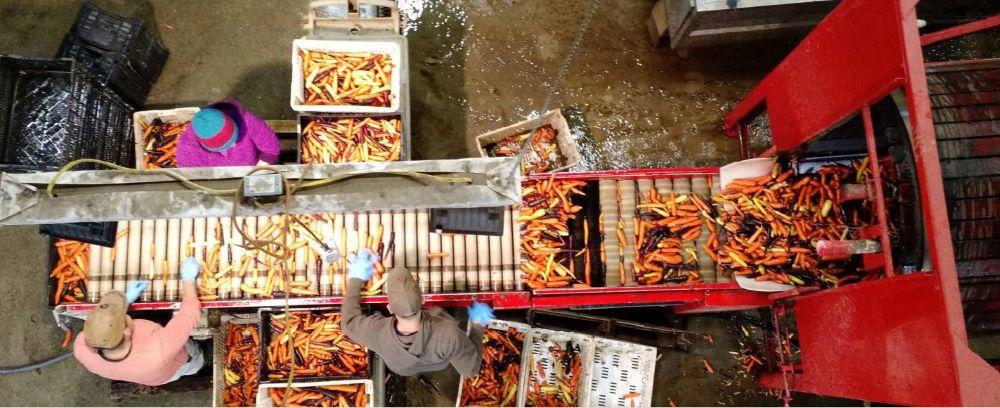
Significant challenges are on the horizon for more than 1,000 produce farms that add diversity and innovation to Vermont’s agricultural economy, which is otherwise largely dependent on the commodity dairy industry. Though small in proportion to dairy, produce farms (excluding apple farms) generate over $50 million in annual sales, employ thousands of (mostly seasonal) workers, and supply key components of a healthy diet.
Recent growth in Vermont’s produce industry has been fueled by demand for healthy local food and sustained by innovative growers that produce high-quality crops. This diverse industry is comprised of farms growing various combinations of vegetables, berries, and ornamental crops, both in the field and in greenhouses (apples are considered produce but are discussed in the Apples brief). Many of these farms also produce tree fruit or livestock, and some produce hemp, mushrooms, and an array of value-added products. Farms range in size from a few acres to a few hundred acres, and they sell primarily to retail and wholesale markets in-state. Growth in this sector appears to be leveling off due to competition for markets, high production costs, regulatory obstacles, and lack of affordable labor. The future of many of the larger farms in this sector is threatened by their lack of a farm succession plan.
The 2017 Census of Agriculture found 716 Vermont farms selling vegetables, about 400 farms selling berries, 220 farms selling floriculture and bedding plants, and 199 farms selling greenhouse tomatoes. These farms had aggregate sales of $48 million out of the $52 million in total annual produce sales. In 2019, the Vermont Vegetable and Berry Growers Association had 360 member farms, up from 213 in 2010. USDA-Natural Resources Conservation Service has funded over 400 high tunnel greenhouses in Vermont totaling 1 million sq. ft. since 2010. In recent decades many new farmers markets, CSAs, and roadside stands have been established. New farmers continue to arrive, both young people and people changing careers. Many come from out-of-state, or return here after working elsewhere, attracted to Vermont’s innovative grower and marketer community, and its passion for local food and farms.
Vermont has about 70 summer farmers markets, 17 winter farmers markets,1 65 CSA farms,2 91 pick-your-own farms,3 and hundreds of farm stands. Although total direct-to-consumer sales continue to grow, anecdotal consensus is that direct markets for fresh produce are becoming saturated, so when new enterprises get established they take customers from existing markets.
Although unsaturated niches exist, the potential for a lot more growth among direct markets seems low. Smaller farms could sell to wholesale markets, but in general those prices are not high enough to sustain farms that are used to getting retail prices from direct sales. A relatively small number of farms are selling to out-of-state retail customers through CSA delivery (e.g., Muddy Boots Farm collaborative), value-driven aggregators (e.g., Farmers To You), and specialty distributors (e.g., Meyers Produce). Those markets have potential for growth given larger urban populations in nearby states, and the capacity of Vermont growers to deliver high-quality, organic, and ecological products for much of the year as well as the widespread adoption of improved food safety, cold storage, and winter greenhouse production techniques.
Direct-to-store wholesale (not through a distributor) is a profitable and reliable market for many mid-sized produce farms, but sales may no longer be growing. This market, and other larger wholesale markets for fresh produce, are very competitive, with prices strongly influenced by low-cost, out-of-state producers. Unless per capita consumption of produce increases, new sales to retailers and distributors must come at the expense of existing and often well-established market relationships.
Supermarkets buy and sell a lot of produce (though specific data is lacking) but logistical barriers to entry are high and prices paid to producers are typically lower than those offered by health food stores, food co-ops, and some independent markets, which tend to buy in smaller volumes. Our larger vegetable farms are best suited to consistently supplying supermarkets, though a few smaller growers have developed strong market relationships with a nearby supermarket. According to grower testimonials, not many institutions (e.g., schools and hospitals) buy enough volume of produce, nor consistently enough, at fair prices to make that market viable. The few that do have organizational and cultural commitments to local food tend to go beyond economic motivations.
Value-added beverage and frozen opportunities exist for berries, but Vermont has only a handful of growers devoted exclusively to berry production, and most are at a scale better suited for PYO or direct-to-store sales. Vermont frozen fruit research shows that frozen production favors scale, requires significant investment and management acumen for post-harvesting labor, equipment, and quality control, and increased product liability coverage and food safety certifications.

